Crushed roots and dyed leaves: Lessons woven across time
The Injalak weavers make their own dyes from seasonal plants to colour pandanus leaves in earthy shades of yellow, brown, red and orange.
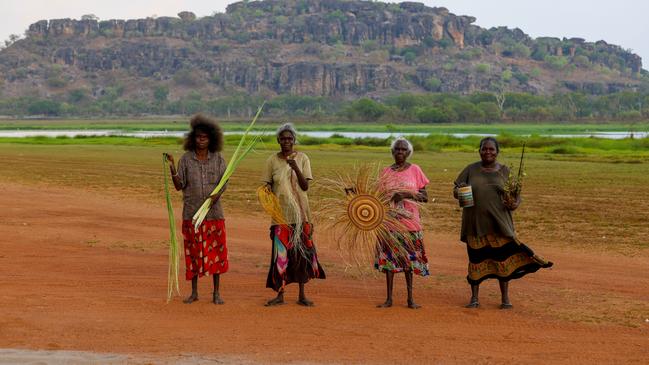
Sitting in the shade outside Injalak Arts Centre in West Arnhem Land, Lorraine Namarnyilk is talking about the time a local family encountered a bit of trouble while coming home from a hunting trip. It was the wet season and the lush billabong at the edge of their community of Gunbalanya had swollen. They drove up to Gerk Gerk Crossing, which was inundated.
“The water was getting high and they were crossing the road when a croc jumped on the bonnet,” she says. “They were reversing and some of the people were shouting with the kids and mother in the car.”
Tales of crocs are legendary around Gunbalanya. There was the time the water rose so high in the wet season that a couple of crocs made their way into the local sports and social club at the back of town. Then there was the nasty croc by the billabong that was chasing the children.
It’s not the wet season yet but at the beginning of October there are signs the rain is on the way. The air is soupy, the clouds are brooding and women are lighting fires in the grass by the billabong to hunt for longneck turtles. Burning the grass makes the animals easier to spot – plus the smoke scares away any crocs that might be hiding in the reeds. If you’re lucky enough to find a turtle you can stick it in the shower at home until you’re ready to cook it.
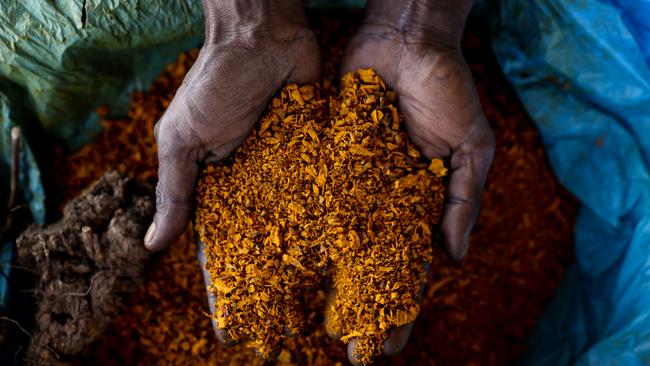
Namarnyilk is a respected Kunwinjku artist who usually works as a painter but today she is sitting cross-legged on the ground using a stone to smash a root while basket weaver Priscilla Badari prepares a fire. Badari, 55, takes the crushed roots and places them in a billy over the coals; they will be boiled to make a dye to colour pandanus leaves to weave into beautiful baskets, mats and dilly bags. Badari has a slight frame but don’t be fooled; when it comes to digging the stubborn roots out of the ground in 38C heat she uses a shovel like a weapon.
Earlier in the day we all pile into a van, red dirt cascading in our wake, and drive to the outskirts of Gunbalanya to look for a native grass. It takes Badari at least 10 stabs at the ground under the menacing sun to release the hardy plant from the earth.
“See, it’s red,” she says proudly, shaking the dirt from the crimson roots. “But we use (wirdilwirdil) to make brown.”
The Injalak weavers make their own dyes from seasonal plants to colour pandanus leaves in earthy shades of yellow, brown, red and orange. These colours are now on show in the exhibition Kala Kunbolk-Colour Country at Art Gallery of South Australia in Adelaide as part of the annual festival of Aboriginal and Torres Strait Islander Art, Tarnanthi.
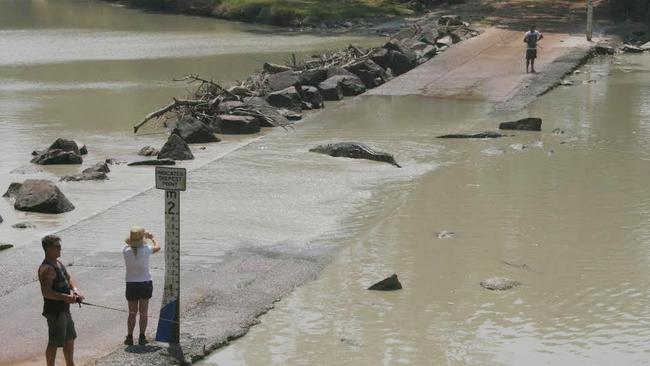
Review takes the 3½-hour drive to Gunbalanya from Darwin via Cahills Crossing over the East Alligator River. The closest town is Jabiru, where the main hotel is in the shape of a crocodile. There are stories of impatient drivers attempting the crossing when the water is too high, of being swept into the river and stalked by crocs. Crawling along at low tide, we make out a couple of flanks barely breaking the surface of the water. We are being watched. When the rains swell this river in a couple of months an airstrip will be the only way to get to Gunbalanya.
Injalak Arts interim chief executive Nina Haigh has lived in the community for the past four years. “There is something about Gunbalanya that really has my heart,” she says. “It’s so beautiful and throughout the season the landscape is so incredible. Community can be hard, and living and working remote can be hard, but it’s just a very rewarding and beautiful place. I love working with those women and being out bush with them.”
Haigh says Injalak works with hundreds of weavers across the community and the surrounding outstations. She was working last year with a group of senior fibre artists at Injalak – Merrill Ngalkalkdjam Namundja, Connie Nayinggul, Doreen Djorlom and Christine Nabobbob – to prepare for an exhibition when they came up with an idea for Colour Country, an intergenerational project that would help people to understand the weaving process and also involve some of the younger women who are often stuck at home caring for children.
“Connie and I had discussed creating an environment where they can bring the kids or we can help get kids looked after,” she says. “We wanted to get the young girls helping the old ladies to get the pandanus but at the same time (allow) those old ladies to tell them the right way to do things.”
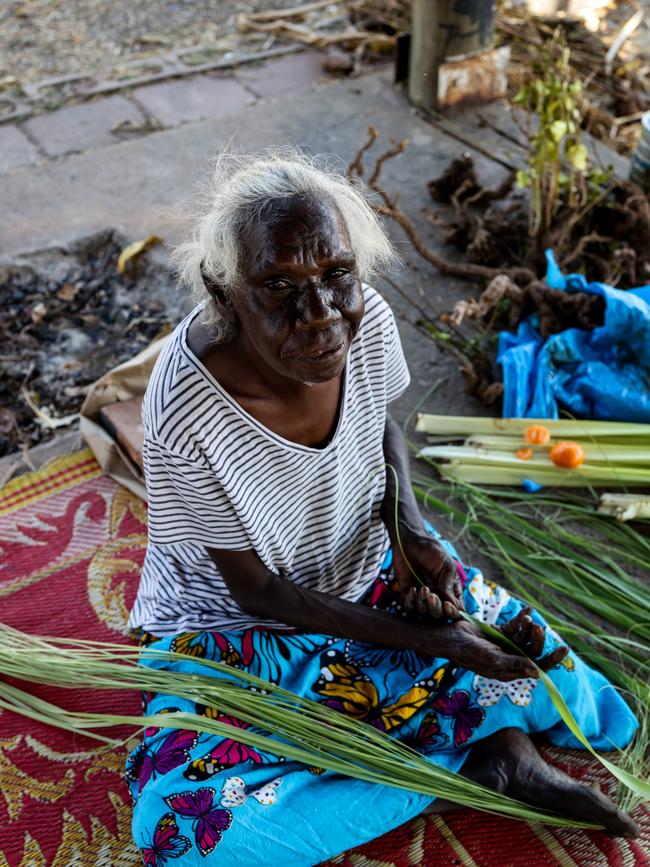

About 16 weavers participated in women’s camps, held in March and July, for which they collected pandanus and harvested plants for dyes. Nayinggul and Haigh co-directed a short film about the trips that is showing at Tarnanthi alongside a collection of vibrant baskets woven by the women and an 8m handpainted banner by Namarnyilk showing the weaving process.
Usually different colours are used for weaving, but for Tarnanthi the artists have created 13 monochrome baskets to highlight the tonal shifts of the natural dyes and the seasonal plants from which they are derived.
“We wanted to show that no matter the size of the basket or earring or bangle, it is at least a week worth of process,” Haigh says. “Fibre art can be perceived as quite crafty. It is an incredible craft, but I think it is very important now within the Aboriginal art scene to see it as an art form in the same way that a painting or a sculpture would be considered.”
Harvesting leaves from the pandanus tree is incredibly physical. On another searingly hot day at Gunbalanya Review joins a group of women in a Troopy – packed with an Esky full of ice – for a quick trip 10 minutes down the road.
We arrive at the base of Injalak Hill, home to some of the most striking rock art galleries in Arnhem Land. Fibre artist Lynne Nadjowh takes a long stick with a claw-like end and uses it to saw at the pandanus leaves before yanking them free with her hands. A camel-coloured spider runs out from the tree and she skips over it with bare feet.
With the giant rocks of Injalak Hill presiding over the expedition, we’re reminded that this is Stone Country. As dusk unfolds that evening the egrets wade among the waterlilies at the edge of the billabong and we are treated to an Arnhem Land symphony. The buzz of cicadas; squawking bats in the trees; the high-pitched chatter of a gecko. Smoke hangs thick in the air. The clouds look so bloated they could burst any moment but it’s still too early for the wet season rains.
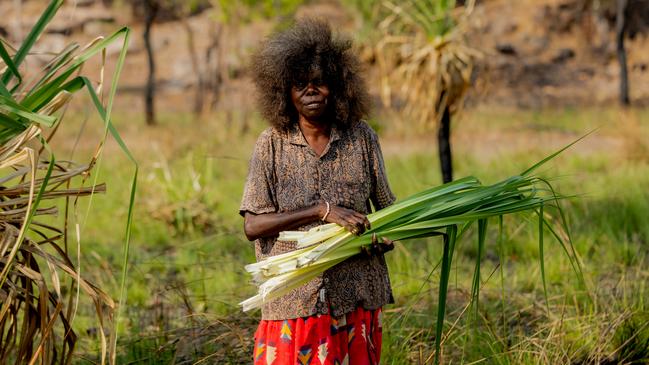
Four years ago Injalak was in turmoil. The federal government’s Registrar of Indigenous Corporations put Injalak into special administration after the arts centre “overextended itself through some large-scale projects placing significant pressure on its financial position”. The ABC reported that Injalak ended up in debt to a builder to the tune of about $1m.
One year later the arts centre was handed back to its members. Injalak chairwoman Donna Nadjamerrek said that time provided important lessons.
“After we went under special administration because of the bad management in the past … we thought no, it’s not going to happen again,” says Nadjamerrek, sitting on the veranda outside her home in Gunbalanya. “We moved on with the business ... we are learning about governance, how we can look after our management, our business.”
During the past decade, Nadjamerrek has seen many developments at Injalak, from an Instagram account showing the artists working and adventuring on country, to the Etsy store selling their textiles and woven earrings, to the collaboration with designer Ally Beahan on a collection for last year’s Melbourne Fashion Week.
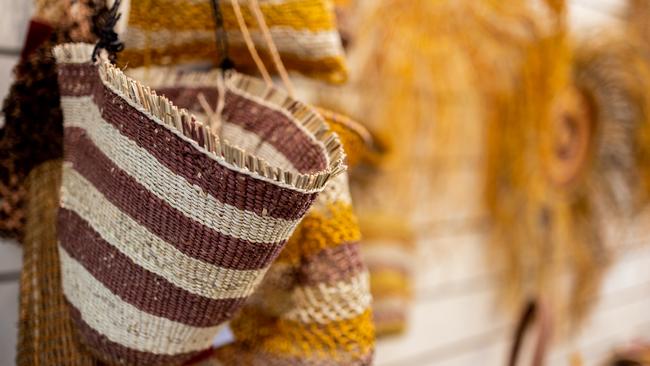
When it comes to her future hopes for Injalak, Nadjamerrek is keen for management to “work towards and have a strong governance in place”. She is unaware of the controversy surrounding the APY Art Centre Collective – allegations of white interference in black art at APYACC, which the collective denies – but says all art centres should formalise a way of protecting their intellectual property.
“You really need to protect your art centre, your resources, your material,” Nadjamerrek says. “Don’t share too much but try to protect it. Every art centre needs to know the process of it. Every art centre should be protected.”
Fifty-four Aboriginal and Torres Strait Islander art centres are selling their art in person or online at the Tarnanthi Art Fair this weekend. Among them is the APYACC, which was expelled from the Indigenous Art Code in June and is being reviewed by the South Australian government following the allegations published in a months-long investigation by this newspaper’s reporter, Greg Bearup.
When asked why the APYACC was included in Tarnanthi 2023 despite its expulsion from the code and an ongoing investigation, a spokesperson for the gallery said: “Planning for Tarnanthi 2023 and the 36 partner projects pre-dated the review and the coverage preceding that announcement. As the review remains ongoing and its findings are yet to be released, AGSA’s decision was to continue as planned.
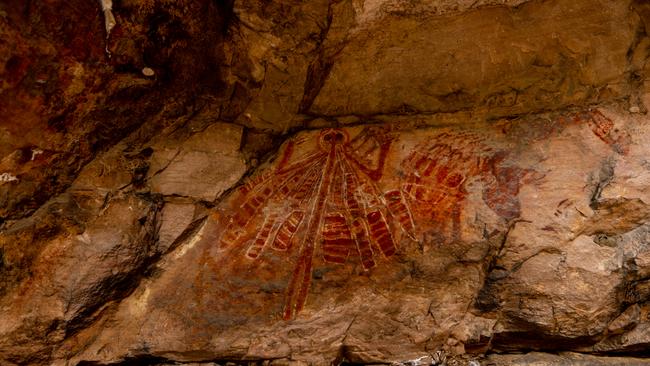
“All artists and the art centres participating in the Tarnanthi Art Fair have agreed to abide by best practice protocols, including those of the Australia Council and the Indigenous Art Code.” They added: “Membership of the IAC is not a requirement for any of the artists or art centres.”
Tarnanthi is showing the first major survey of Vincent Namatjira’s paintings, which also will travel to Canberra next year. It includes a new painting AGSA is set to acquire, entitled Albert Namatjira, Slim Dusty and Archie Roach on Country, in which the two songmen cradle their acoustic guitars as esteemed Hermannsburg painter and Vincent’s great-grandfather Albert looks on.
Tarnanthi artistic director Nici Cumpston says the exhibition is a highlight of the festival, as is the Colour Country film that shows the landscape around Gunbalanya.
“It’s exquisite, beautiful footage of that country, a lot of drone imagery going in and over the top of Injalak Hill. You can see the escarpment and the flood plain. It gives you that full experience of being on that country when you’re watching that moving image.”
■ ■ ■
It’s morning on community and one of the artists has built a fire on the sand outside the arts centre to cook up a wild pig. Today is Sunday, a day for hunting. Thirty-year-old artist Sprotin Bangarr, who proudly shows us his painting of catfish on a contemporary salmon background, takes us to Injalak Hill to show us the rock art. At the top of a steep climb is a painting of the creation mother, Yingana, with her dilly bags.
Back at the arts centre under a small gazebo Priscilla Badari explains that the dilly bags, which can be dipped in wax to carry water, are also part of her people’s genesis story. “Yingana was the creation mother and used to carry the dilly bags with all the babies inside,” she says. “The ancestors passed this story over to elders and they pass it over to us.”
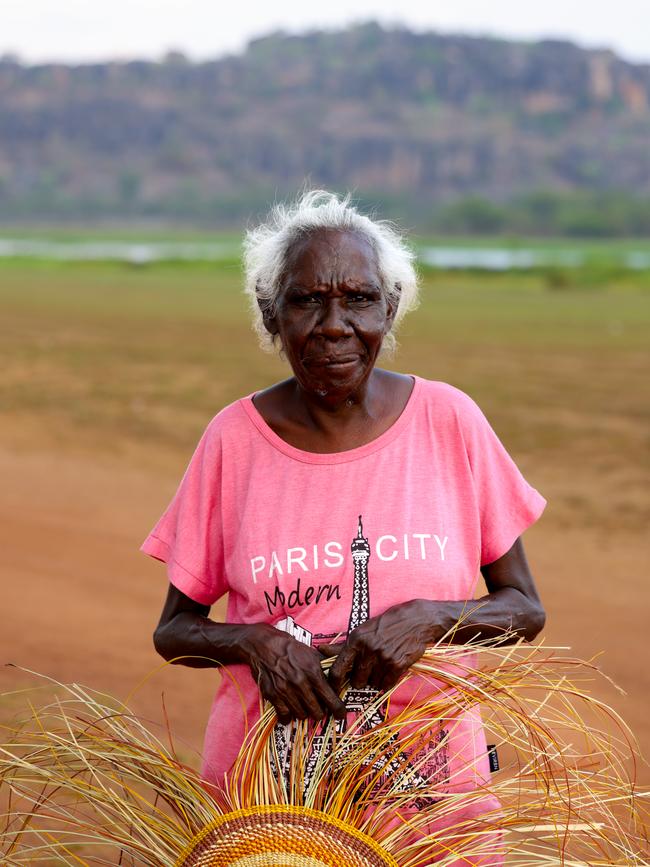
Yesterday they collected two bags of pandanus, enough to weave asmall bowl over the course of about two weeks. Badari peels the pandanus into thin ribbons she keeps neatly between her toes. The tiny prickly hairs on the leaves make her fingers sting a little. She learned to do this from her mother, her grandmother and her aunty. Now she is a teacher. “I’d watch them and get the little smooth part and practise peeling the pandanus,” she says. “Now I teach family members and sometimes school kids.”
Tarnanthi is held at Art Gallery of South Australia in Adelaide and at participating venues across South Australia until January 21 next year. Tarnanthi Art Fair runs from Friday October 20 to Sunday October 22 at the Adelaide Entertainment Centre. Bridget Cormack travelled to Gunbalanya with the assistance of AGSA.
Saul Steed


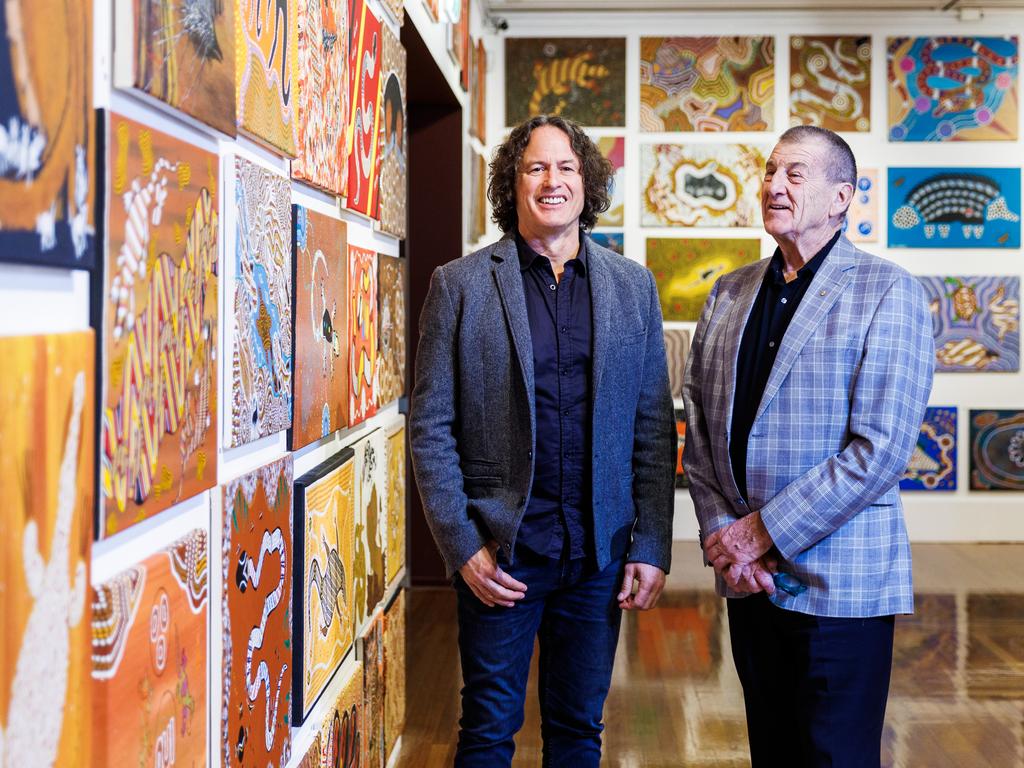



To join the conversation, please log in. Don't have an account? Register
Join the conversation, you are commenting as Logout